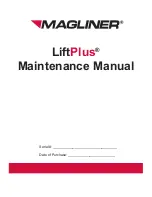
How to Perform Planned Maintenance
7-25
Section 7. Planned Maintenance and Lubrication
Engine Oil Performance Designation
: Refer to the “Engine Oil” in Section 8.
Hydraulic Sump Tank
Check the hydraulic sump tank fluid level. Correct fluid level is
important for proper system operation. Low fluid level can cause
pump damage. Overfilling can cause loss of fluid or lift system
malfunction.
Hydraulic fluid expands as its temperature rises. Therefore, it is
preferable to check the fluid level at operating temperature (after
approximately 30 minutes of truck operation). To check the fluid
level, first park the truck on a level surface and block the drive
wheels. Put the upright in a vertical position and lower the fork
carriage fully down. Pull the dipstick out, (attached to the sump
breather) wipe it with a clean wiper, and reinsert it. Remove dipstick
and check oil level. Keep the oil level above the LOW mark on the
dipstick by adding recommended hydraulic fluid only, as required.
Do
not overfill
.
Check the condition of the hydraulic fluid (age, color or clarity,
contamination). Change (replace) the oil as necessary.
Hydraulic Fluid and Filter Change
Drain and replace the hydraulic sump fluid every 2000 operating
hours. (Severe service or adverse conditions may require more
frequent fluid change). Replace the hydraulic oil filter elements at
every oil change. Remove, clean, and reinstall the hydraulic and
steer system suction line screens at time of fluid change. Check for
leaks after installation of the filters. Also, check that the hydraulic line
connections at the filter adapter are tightened correctly. The
procedure for draining hydraulic sump tank is in your Service
Manual.
Summary of Contents for S20 D
Page 2: ......
Page 6: ...iv...
Page 16: ...1 4 Seat Belts Seat Belts ALWAYS BUCKLE UP Seat belts can reduce injuries...
Page 30: ......
Page 118: ......
Page 139: ...PM Report Form 7 13 Section 7 Planned Maintenance and Lubrication...
Page 158: ......
Page 166: ......



































